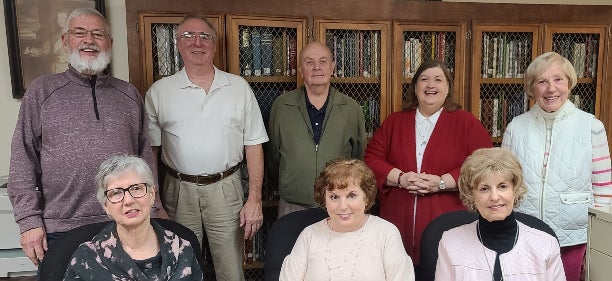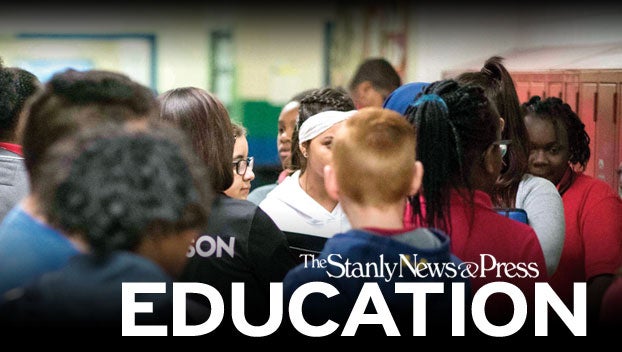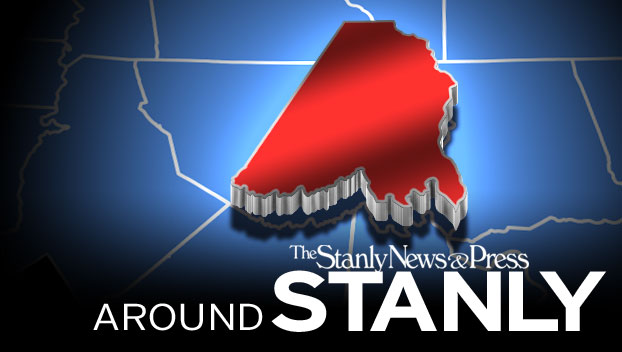Stanly woman traced her ancestry back to the Jamestown settlement. Now she’s helping others do the same.
Published 6:15 pm Sunday, February 27, 2022

- Members of the Jamestowne Society, front row, from left: Joyce Eury Lambert, Debbie Frye Noah, Lois Harwood Marlow; back row: JD Burleson, Jim Harwood, David Almond, Pamela Hannah Woods, Patricia Austin Edwards. Not present were members Janice Abernathy and Nadine Bowers. Photo courtesy of Debbie Noah.
|
Getting your Trinity Audio player ready...
|
Three years ago, Debbie Noah received a phone call from her niece Anne Brown, a student at Appalachian State University. She was writing a paper on her family’s genealogy and needed help.
Being several years older than Brown’s mother, “she felt like I would know more about the family history,” Noah said. She had always been curious about her family’s ancestry but never had the time to thoroughly look into it.
Wanting to find information for her niece, Noah, who lives in New London, began her research by first going to the The Margaret Johnston Heritage Room in the Stanly County Museum. She worked her way through her mother’s side of the family. With the help of census records and birth, marriage and death certificates, she was able to piece together generation after generation.
“I just kept going further and further back,” she said. “I don’t consider myself a genealogist as much as a researcher and a detective.”
As a history enthusiast, she said digging into her family’s past “was just right down my alley.”
What began as a way to help her niece ultimately turned into a years-long quest to discover as much as she could about her family’s ancestry. Her journey took her to libraries in Rowan and Montgomery along with several trips to the State Library of North Carolina in Raleigh.
After discovering her seventh great-grandfather, Joseph Harwood III, hailed from Virginia, she also made a few treks to the Library of Virginia in Richmond. She learned that Harwood’s sons Absalom and William migrated to North Carolina, before eventually securing property in what was then Montgomery County, but is now Stanly. Noah is descended from Absalom’s son Malachi.
After about two years of nonstop research and putting the pieces together, Noah traced her lineage back 14 generations to a woman named Cicely Baley — her 11th great-grandmother — who lived in Jamestown, which was part of the colony of Virginia and is best known as being the first permanent English settlement in the Americas. Jamestown was formed in 1607, 13 years before the Pilgrims arrived on the Mayflower and almost 170 years before the signing of the Declaration of Independence.
While it’s not necessarily rare to have an ancestor dating back several hundreds of years, what impressed Megan Sullivan, director of the Stanly County Museum, was that Noah was able to locate the necessary paperwork directly tying her with Cicely. As a historian, finding specific documents, especially ones dating back hundreds of years, can be similar to finding a needle in a haystack.
“To find the records to trace your ancestry that far back, that’s great, that’s amazing,” she said.
Who was Cicely Baley?
Cicely Baley, according to Noah’s detailed research, arrived in Jamestown from England in 1610 at age 10 and established herself as one of the few female ancient planters about a decade later. The term applied to early colonists who migrated to the colony of Virginia when it was managed by the Virginia Company of London. They each received a grant of 100 acres of land as their dividend for investing in the Virginia Company, provided they stayed for at least three years.
She was married many times, beginning with a man named Baley, who fathered her first of many children, a girl named Temperance Baley, who is also Noah’s ancestor. Once her first husband died, she eventually remarried Samuel Jordan and they lived at Jordan’s Journey, a 450-acre plantation on the James River.
Cecily and her family survived a surprise Indian attack in 1622, which killed about a third of the colonists in Virginia, though everyone at Jordan’s Journey survived.
Following Jordan’s death in 1623, Rev. Greville Pooley became interested in Cicely and even claimed to have proposed marriage to her and also claimed she accepted. Cicely preferred William Farrar, a man who moved to Jordan’s Journey following the attack, and wanted to marry him. Pooley then sued Cicely for breach of promise, the first such case in America. After two years of litigation, the case was resolved in Cecily’s favor in 1625. Cecily and Farrar eventually married and had several children together. She died sometime after 1632, though Noah has not found an exact date.
Noah was at first shocked to learn she descended from someone with ties to early America and spent time making sure her research was correct.
“Everything I found on her I would pick apart just to make sure it was accurate,” she said.
What Noah finds fascinating about Cicely is that no matter the obstacles she faced, she achieved a level of success that was extremely rare for a woman in those days. She was named, for example, in the Jamestown Muster of 1624/25 as being head of the household at Jordan’s Journey along with Farrar.
“She survived all the hardships that she ran into,” Noah said. “She must have been extremely strong.”
As a tribute to her ancestor, Noah wanted to spread the word to other descendants in the area — and there are plenty. Cicely’s great-granddaughter Agnes Cocke was the first to marry into the Harwood family. Several generations later, once William and Absalom were living in Stanly County, the spelling of the last name changed — while some of the descendants were still Harwoods, many others became Harwards.
Over time, Noah has found members from numerous Stanly families with the last names of Lowder, Hatley, Eudy, Green, Whitley, Almond, Furr and Burleson, among others, are part of the Harwood/Harward lineage and therefore can trace their ancestry back to Cicely.
Becoming a member of the Jamestowne Society
Though Noah grew up in Stanly County, she spent eight years in Virginia, where she learned about the Jamestowne Society. To be eligible to join the organization, which was created in 1936, individuals must prove they are a direct descendant of a qualifying ancestor who lived or held colonial government positions in Jamestown prior to 1700. There are currently about 10,500 members across the country, Noah said.
On the Society’s website, it includes a list of hundreds of qualifying ancestors, including two mentions of Cicely. Because 17th century spelling was quite variable, she is actually listed twice — as Cicely Baley and as Sisley Jordan.
Once Noah discovered her link with Cicely, she set about to become a member. She contacted executive director Bonnie Hofmeyer, who became her sponsor. Needing detailed proof of documentation (mainly birth, marriage and death certificates) connecting each generation, it took Noah close to a year to gather all the materials. She submitted her application last April.
About two weeks after she applied, the head genealogist emailed her, expressing some doubt, as no one before had traced their lineage to Cecily via the Harwood line. He wanted her to prove the migration pattern of the Harwoods from Virginia to Montgomery County.
Noah went back to Raleigh and spent about a month uncovering the relevant land grants and land transfers needed to prove her ancestors had settled in Montgomery.
“I was lucky enough to find them,” she said.
Even after submitting the additional paperwork, Noah was not feeling optimistic about her chances of becoming a member.
“I had just really almost given up at that point,” she said.
After verifying the required documentation, though, Noah received her long-awaited acceptance letter on May 12.
“I just had to sit down when I got it,” she said. “It was more than I could take in at the time.”
Finding a way to help others
Since her inclusion, she has helped nine others join the organization using the Harwood/Harward line, by sharing with them her research and sponsoring all but one of them. The total number of members could soon swell to 12 as there are two individuals whose applications are pending.
One of the people she sponsored was Lois Marlow, who grew up in Albemarle and now lives in Concord. As someone who is part of several historical societies, including the Colonial Dames of America and the local chapter of the Daughters of the American Revolution, Marlow knew her lineage dated back to at least Joseph Harwood III, but did not know it went back 11 generations to Cicely.
“I was absolutely amazed,” she said, noting that when Noah told her she was eligible to become a member of the Jamestowne Society, “I immediately said, ‘Oh my gosh, I want to join, I want to join.’ ”
David Almond was first contacted by Noah a few months ago. As someone who’s long been interested in genealogy, he traced his ancestry back 150 years to the Harwood line, but, like Marlow, didn’t know his roots extended back to Jamestown until Noah stepped in and completed the research.
“Debbie is a real dynamo. There’s not hardly anything she can’t do from painting in the Snuggs House to cleaning up an old cemetery to doing historical research,” he said. “She is multi-talented and a very intelligent woman.”
While he enjoyed becoming a member of the society, what Almond appreciated most was having an officially recognized paper trail.
He was not surprised that so many people in Stanly shared a common ancestor due to the prevalence of certain last names such as his own.
“There’s lots of Almonds in Stanly County,” he said. “My mother was a Whitley and there’s lots of those. Her mother was Furr and there’s lots of those…They’re so many people I’m kin to that it doesn’t surprise me when I find out about it anymore.”
In the Spring 2022 edition of the Jamestowne Society Magazine, nine new members were listed as having descended from Cicely, including Marlow and Almond.
For Noah, as exciting as it was to discover her roots, she most enjoys informing others in the community about their lineage and letting them know about the Jamestowne Society.
“I’m most proud and happy and elated when I get the phone call and they say, ‘Debbie, I got my papers, I’m in Jamestowne,’ ” she said. “I’m as excited for them as I was when I got mine.”
Noah and the other Stanly members of the society, who met for a photo op at the Stanly County Museum a few weeks ago, are traveling to Virginia in early May to learn more about Jordan’s Journey and their common ancestor Cicely.
She’s told her children and grandchildren about their connection to Jamestown and hopes they will continue to pass the information on to their descendants to help keep Cicely’s story alive.
“In order to honor Cicely in my own way, is to help everyone else become aware of her,” she said. “That’s my mission.
“I’m leaving something behind like she left for me,” she added.






